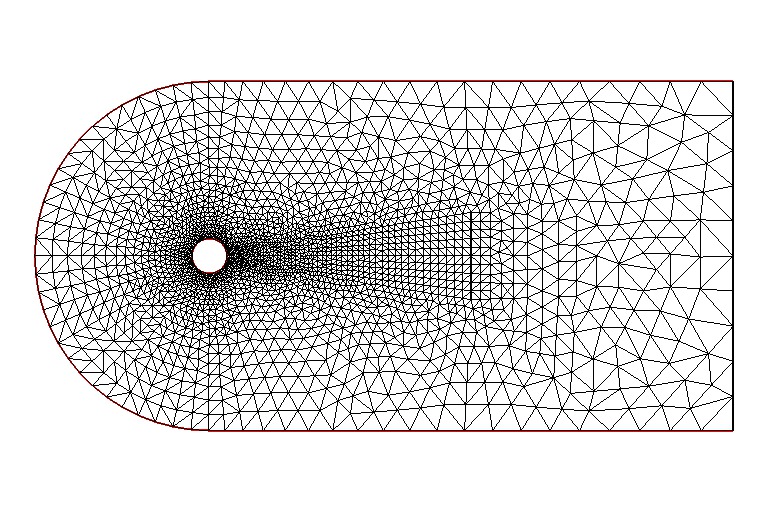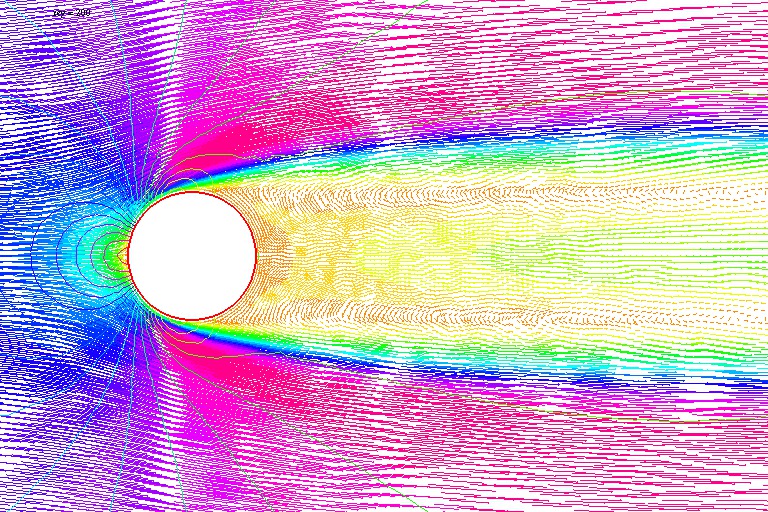Here you can use the search bar to search in all FreeFEM examples instead
The list of all matching examples on the right is updated for each new query
Clicking on a search hit or on an example on the right brings up the corresponding script from GitHub
You can also filter the list on the right by selecting one or more intersecting categories on the left tree
Newton Method for the Steady Navier-Stokes equations
The problem is find the velocity field \(\mathbf{u}=(u_i)_{i=1}^d\) and the pressure \(p\) of a Flow satisfying in the domain \(\Omega \subset \mathbb{R}^d (d=2,3)\):
where \(\nu\) is the viscosity of the fluid, \(\nabla = (\partial_i )_{i=1}^d\), the dot product is \(\cdot\), and \(\Delta = \nabla\cdot\nabla\) with the same boundary conditions (\(\mathbf{u}\) is given on \(\Gamma\)).
The weak form is find \(\mathbf{u}, p\) such that for \(\forall \mathbf{v}\) (zero on \(\Gamma\)), and \(\forall q\):
The Newton Algorithm to solve nonlinear problem is:
Find \(u\in V\) such that \(F(u)=0\) where \(F : V \mapsto V\).
choose \(u_0\in \mathbb{R}^n\) , ;
for ( \(i =0\); \(i\) < niter; \(i = i+1\))
solve \(DF(u_i) w_i = F(u_i)\);
\(u_{i+1} = u_i - w_i\);
break \(|| w_i|| < \varepsilon\).
Where \(DF(u)\) is the differential of \(F\) at point \(u\), this is a linear application such that:
For Navier Stokes, \(F\) and \(DF\) are:
So the Newton algorithm become:
1// Parameters
2real R = 5.;
3real L = 15.;
4
5real nu = 1./50.;
6real nufinal = 1/200.;
7real cnu = 0.5;
8
9real eps = 1e-6;
10
11verbosity = 0;
12
13// Mesh
14border cc(t=0, 2*pi){x=cos(t)/2.; y=sin(t)/2.; label=1;}
15border ce(t=pi/2, 3*pi/2){x=cos(t)*R; y=sin(t)*R; label=1;}
16border beb(tt=0, 1){real t=tt^1.2; x=t*L; y=-R; label=1;}
17border beu(tt=1, 0){real t=tt^1.2; x=t*L; y=R; label=1;}
18border beo(t=-R, R){x=L; y=t; label=0;}
19border bei(t=-R/4, R/4){x=L/2; y=t; label=0;}
20mesh Th = buildmesh(cc(-50) + ce(30) + beb(20) + beu(20) + beo(10) + bei(10));
21plot(Th);
22
23//bounding box for the plot
24func bb = [[-1,-2],[4,2]];
25
26// Fespace
27fespace Xh(Th, P2);
28Xh u1, u2;
29Xh v1,v2;
30Xh du1,du2;
31Xh u1p,u2p;
32
33fespace Mh(Th,P1);
34Mh p;
35Mh q;
36Mh dp;
37Mh pp;
38
39// Macro
40macro Grad(u1,u2) [dx(u1), dy(u1), dx(u2),dy(u2)] //
41macro UgradV(u1,u2,v1,v2) [[u1,u2]'*[dx(v1),dy(v1)],
42 [u1,u2]'*[dx(v2),dy(v2)]] //
43macro div(u1,u2) (dx(u1) + dy(u2)) //
44
45// Initialization
46u1 = (x^2+y^2) > 2;
47u2 = 0;
48
49// Viscosity loop
50while(1){
51 int n;
52 real err=0;
53 // Newton loop
54 for (n = 0; n < 15; n++){
55 // Newton
56 solve Oseen ([du1, du2, dp], [v1, v2, q])
57 = int2d(Th)(
58 nu * (Grad(du1,du2)' * Grad(v1,v2))
59 + UgradV(du1,du2, u1, u2)' * [v1,v2]
60 + UgradV( u1, u2,du1,du2)' * [v1,v2]
61 - div(du1,du2) * q
62 - div(v1,v2) * dp
63 - 1e-8*dp*q //stabilization term
64 )
65 - int2d(Th) (
66 nu * (Grad(u1,u2)' * Grad(v1,v2))
67 + UgradV(u1,u2, u1, u2)' * [v1,v2]
68 - div(u1,u2) * q
69 - div(v1,v2) * p
70 )
71 + on(1, du1=0, du2=0)
72 ;
73
74 u1[] -= du1[];
75 u2[] -= du2[];
76 p[] -= dp[];
77
78 real Lu1=u1[].linfty, Lu2=u2[].linfty, Lp=p[].linfty;
79 err = du1[].linfty/Lu1 + du2[].linfty/Lu2 + dp[].linfty/Lp;
80
81 cout << n << " err = " << err << " " << eps << " rey = " << 1./nu << endl;
82 if(err < eps) break; //converge
83 if( n>3 && err > 10.) break; //blowup
84 }
85
86 if(err < eps){ //converge: decrease $\nu$ (more difficult)
87 // Plot
88 plot([u1, u2], p, wait=1, cmm=" rey = " + 1./nu , coef=0.3, bb=bb);
89
90 // Change nu
91 if( nu == nufinal) break;
92 if( n < 4) cnu = cnu^1.5; //fast converge => change faster
93 nu = max(nufinal, nu* cnu); //new viscosity
94
95 // Update
96 u1p = u1;
97 u2p = u2;
98 pp = p;
99 }
100 else{ //blowup: increase $\nu$ (more simple)
101 assert(cnu< 0.95); //the method finally blowup
102
103 // Recover nu
104 nu = nu/cnu;
105 cnu= cnu^(1./1.5); //no conv. => change lower
106 nu = nu* cnu; //new viscosity
107 cout << " restart nu = " << nu << " Rey = " << 1./nu << " (cnu = " << cnu << " ) \n";
108
109 // Recover a correct solution
110 u1 = u1p;
111 u2 = u2p;
112 p = pp;
113 }
114}
Note
We use a trick to make continuation on the viscosity \(\nu\), because the Newton method blowup owe start with the final viscosity \(\nu\).
\(\nu\) is gradually increased to the desired value.


